Muralist Robert Vargas is painting a towering history of L.A. above the traffic

L.A. artist Robert Vargas begins work on his new mural on the corner of 5th and Hill streets.
- Share via
The rope tugs and Robert Vargas is hoisted with brushes and paint to the unfinished face of a child. Lips, nose, chin, she begins to bloom from the side of a building. An eye, five stories up, gleams. She is the color of clay and earth and soon she will be complete, looking over the homeless, glancing at rich girls and Escalades, peeking across the skyline toward the ocean.
“Hey, man,” someone yells from below. “You painted that, right?”
Vargas nods.
“It’s good, man.”
The voice disappears down the alley. Vargas, suspended on a rig for high-rise window washers, turns back to the mural that is coming to life on a 12-story apartment building across from Pershing Square in downtown L.A.. When he’s done later this year, the canvas, 60,000 square feet of wall and windows, will tell the tale of the city with images of the L.A. River, Gustavo Dudamel, indigenous Tongva Indians, an ancient sycamore and three bright-winged angels.
“I’m starting to build a relationship with the wall,” Vargas, who began his work weeks ago, said beneath a spattered straw hat. “I’m in beast-mode now.”
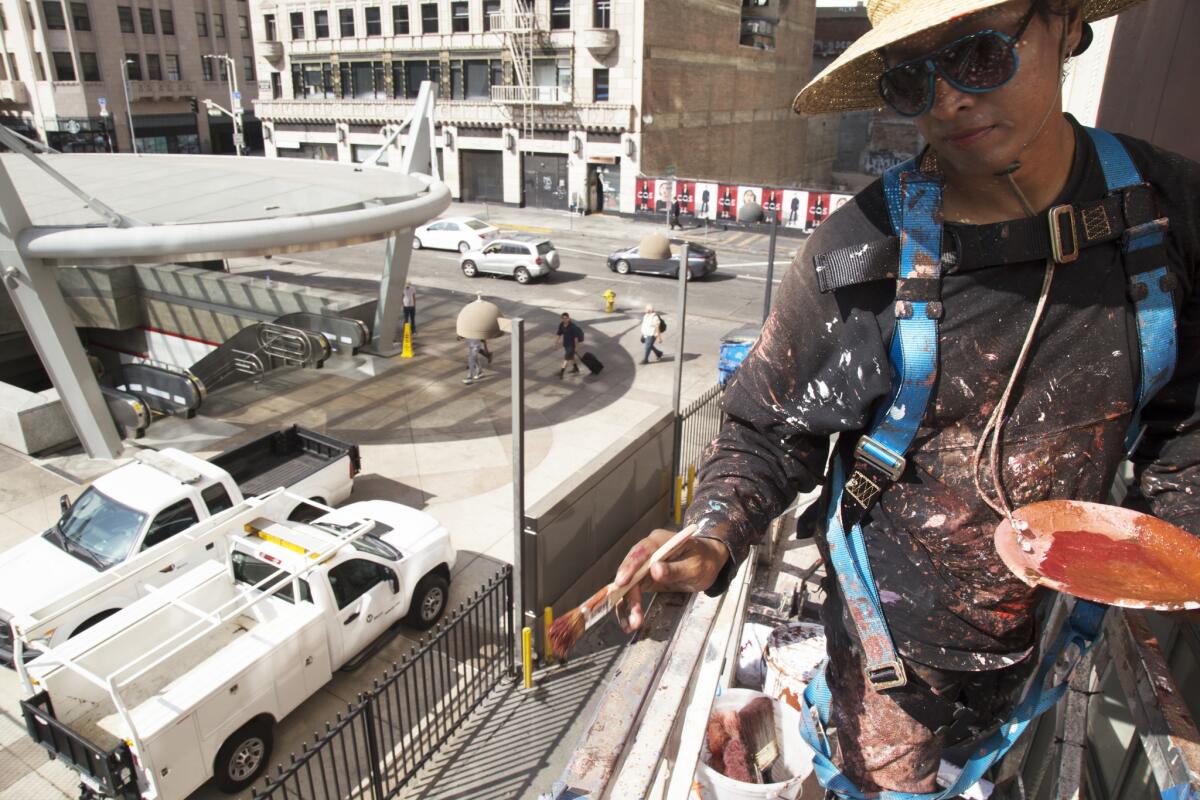
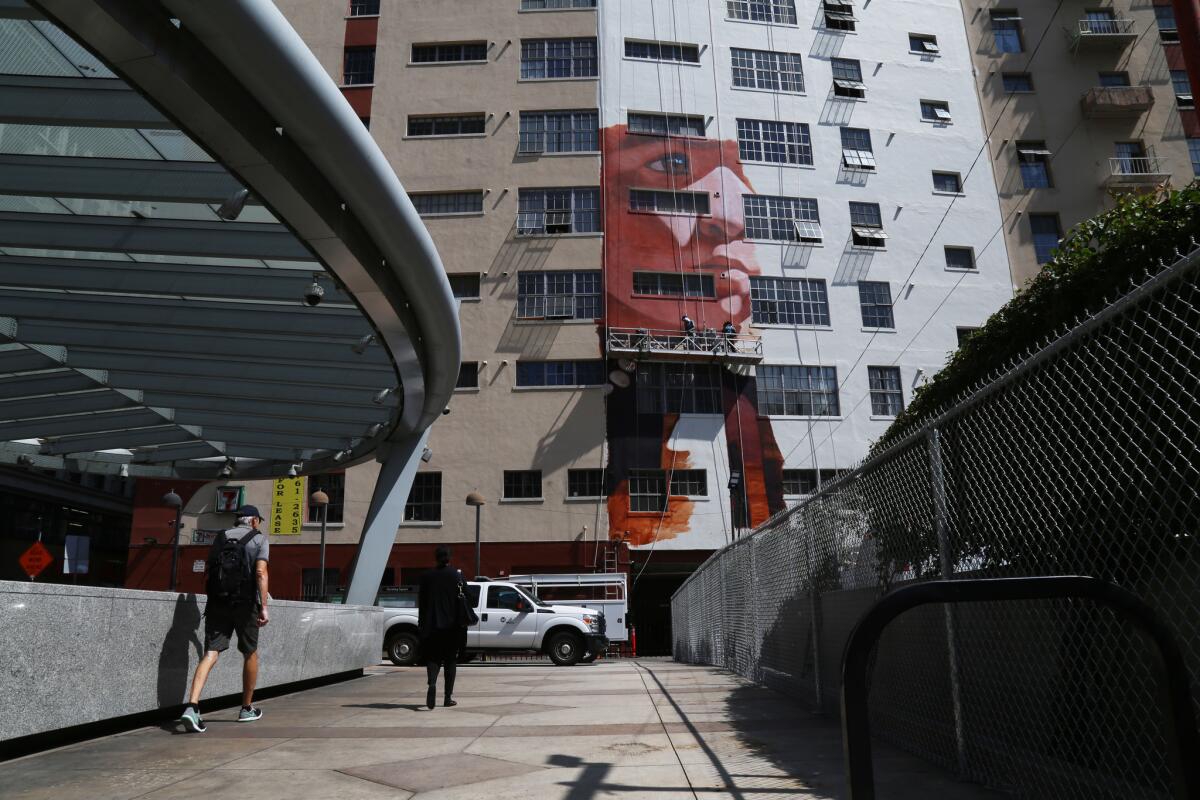
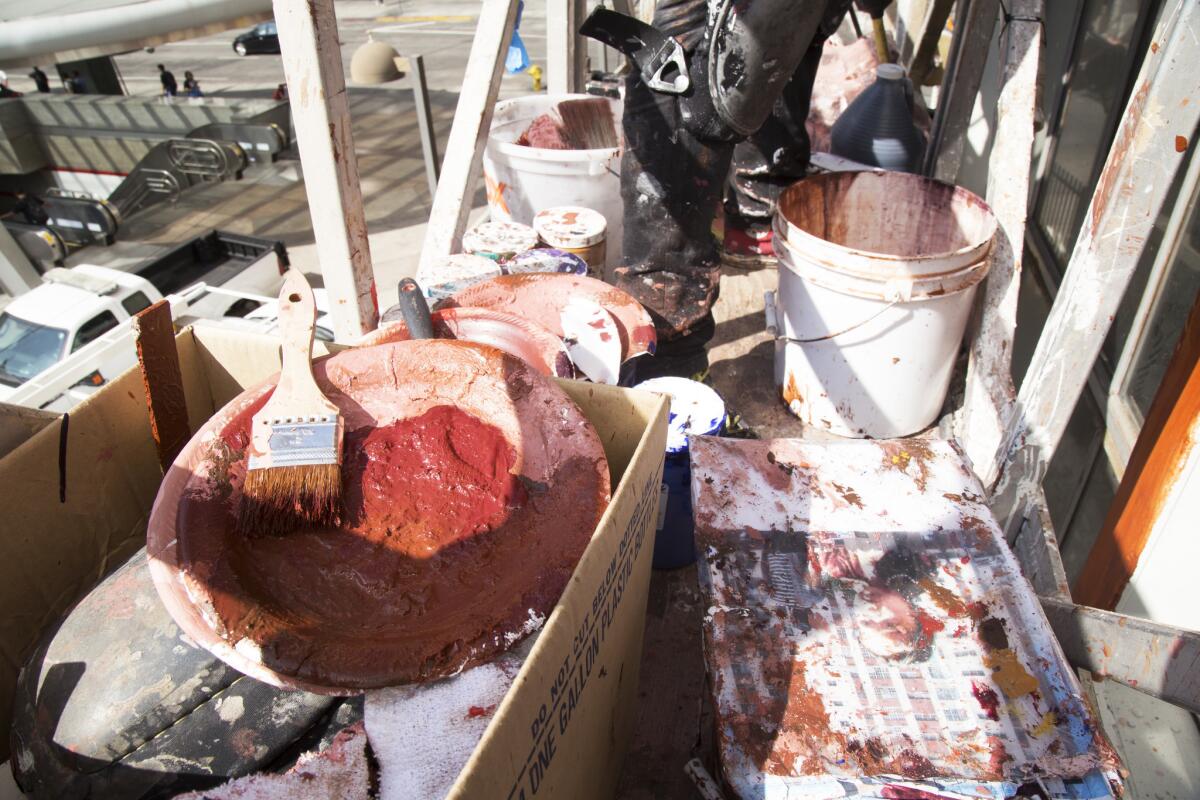
Rising from Venice Beach to Little Tokyo, murals are vivid narratives of the city, montages of politics, identity, civil rights and surrealness that portray characters including Che Guevara, Marilyn Monroe, Filipino farmworkers and the restored Anthony Quinn at the old Victor Clothing Co. They are compressed and towering, shining from brick walls and car washes, glimmering in alleys. Many murals began appearing at least a half-century ago as part of the Mexican American heritage movement; they were banned for a decade, and have been undergoing a resurgence since 2013.
Born to a roofer and a onetime cashier at Clifton’s, Vargas, who grew up in a Victorian in Boyle Heights, is a mercurial son of the city. He’s a skilled self-promoter known for portraits and street art, including the “Our Lady of DTLA” mural at 6th and Spring streets. Vargas at his essence is a populist, an artist who sees in Los Angeles the roots of self and the rebirth of a neglected historic core, where as a child he hopped in his father’s car and rolled past dressed-up crowds and faces peeking from the architecture around the old movie palaces on Broadway.
“My grandmother used to come to downtown to see James Brown and Little Stevie Wonder at the Million Dollar Theater. Some of my relatives were involved in the Zoot Suit riots,” he said. “Boyle Heights gave me a clear sight line to the downtown skyline. Downtown always loomed very large in my periphery. I think because of that I was destined to draw big and paint big.”
Downtown always loomed very large in my periphery. I think because of that I was destined to draw big and paint big.
— Robert Vargas
Vargas was an early supporter of the monthly Downtown Art Walks, crouching over canvases on a sidewalk and sketching portraits of hipsters, homeless, tourists and other passersby. He does about 800 portraits a year, including those in his show at Sur le Mur Gallery at the Pacific Design Center, where he drew actor William H. Macy as a crowd gathered. His “Our Lady of DTLA” summons the spirit of a reawakened city under the gaze of a vigilant heroine.
“She says, ‘This is my downtown. I protect and I welcome,’” said Vargas, who used four models for the face. “I painted her in black and white as a nod to historic architecture, and the halo of gold metallic is a nod to religious icons. She’s got light eyes but dark hair. And without being in full color, she becomes much more universal.”
Vargas’ new mural near Pershing Square, called Angelus to symbolize unity, is a few blocks from Our Lady of DTLA. They represent the story of a painter and his city, a piecing together of art and history in an evolving aesthetic that is at once singular and shared. It is happening as downtown’s borders are increasingly blurred, and the much-talked-about renaissance edges into skid row and once abandoned neighborhoods that are now home to galleries, clubs, curious fashions, food trucks and valet parking.
At night downtown L.A., especially around Spring Street, can feel like a scattering of overlapping worlds. Cranes go silent, construction workers head home and, as dusk slips to dark, movie crews appear amid clubbers, musicians, celebrities, Hare Krishnas banging tin cymbals, scents of perfume and dope, and the dispossessed, talking to themselves and wandering through what seems a strange carnival of incongruities.
“The city center is being rediscovered,” said Vargas, who has trips planned to Europe and Asia as part of his Paint the World series that includes exhibits and murals. “Buildings are being brought back to their glory. L.A. is becoming an art capital that rivals New York, Paris and London. It is entering this creative golden age not just in visual arts but in fashion, music and performance. We’re New York in the early ’80s, we’re Paris at the turn of the last century.”
Isabel Rojas-Williams, an expert on murals who has known Vargas since he was a boy, said, “Robert is one of the artists from the younger generation who is making downtown Los Angeles what it is. As a teenager, he had skill and ambition to be what he is today. His ability to create portraits of people in minutes is amazing.” She added that Vargas is a master marketer, often inviting musicians and actors to his events.
“When you’re a muralist,” she said, “you have to have a big personality.”
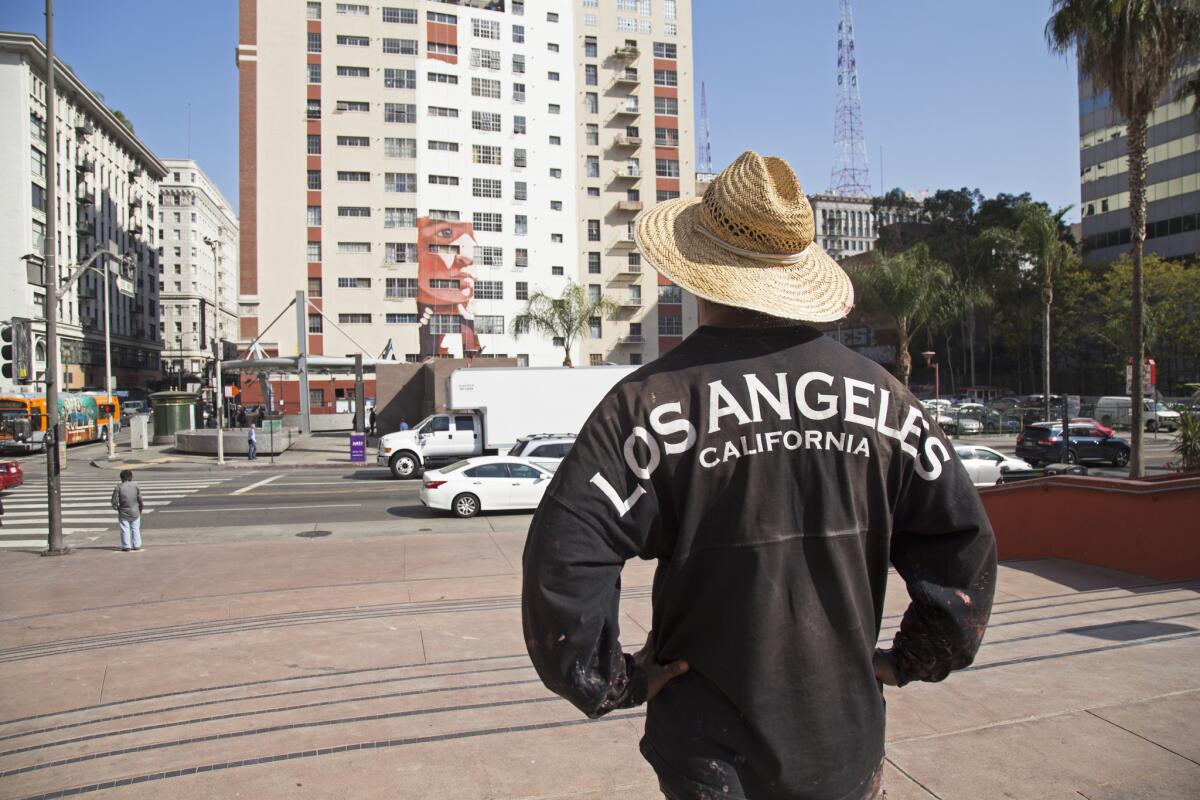
A Man About Town
Vargas is compact, his brushstrokes quick. He often ties his hair up under a black hat, giving him the air of a man who’s just heard an intriguing bit of news.
With a battered, paint-speckled smartphone, he scrolls through Instagram and is keen to the difference between flash and relevance. He fills every hour, leaving his downtown loft and disappearing across sidewalks. His sense of humor comes with a wink. At a sushi restaurant he was told by a companion to go ahead and eat and not wait: “It’s not like it’ll get cold,” he said.
A onetime booking agent at the Conga Room, where he got to know
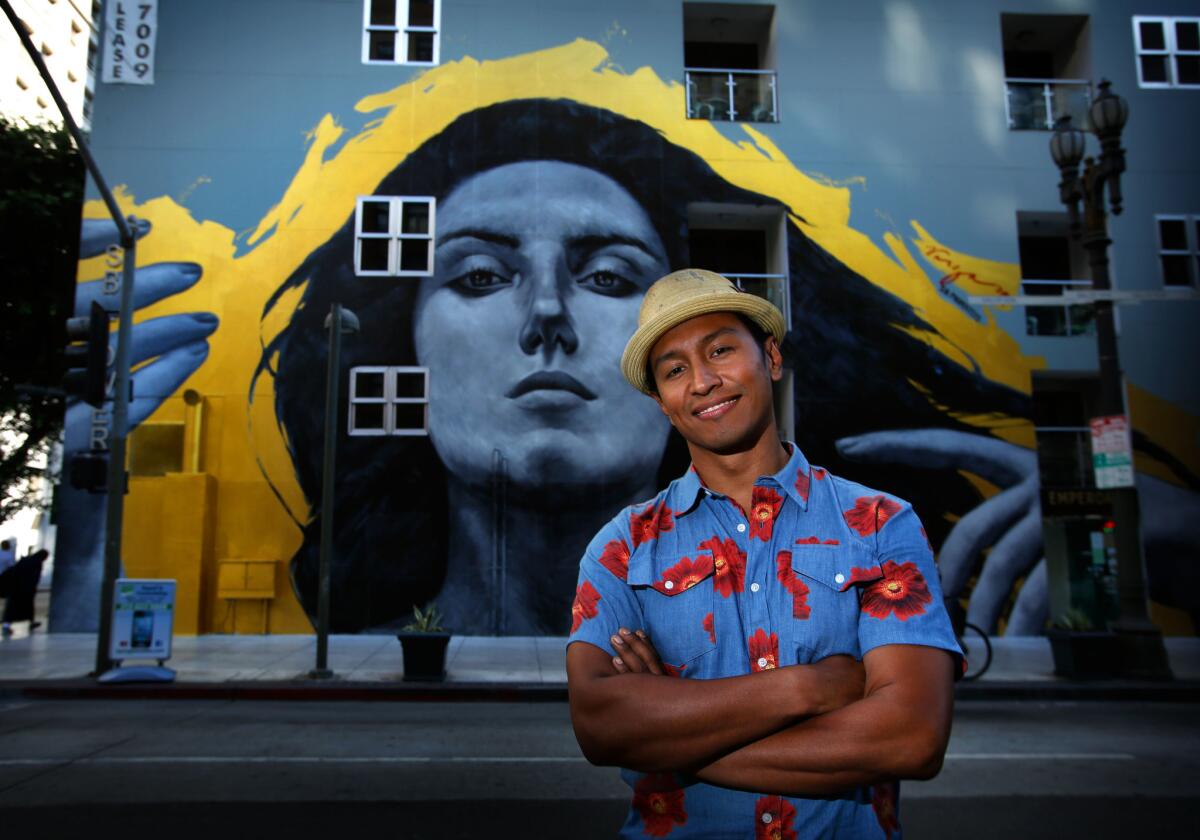
On a recent night, past a security guard smoking a cigar and “The Maltese Falcon” playing on a TV above the bar, the club was reminiscent of an Andy Warhol party: a guitar band played hallucinogenic chords, two dancers pranced in furry boots, a punk-rock geisha glided by a dreadlocked tattoo artist, a Joan Didion look-alike whispered to a friend, and a woman wearing not much except Christmas lights greeted guests until she got restless, unplugged herself and went for a drink.
“What we’re doing here,” Vargas said as he knelt before a canvas to sketch a woman, “is opening up the creative process.” The crowd pressed in. “It’s not so much what the person looks like but the path of discovery we both take while I’m creating the portrait,” he had said earlier. “The silent dialogues that come when I am painting someone are the most captivating for me. I’m painting more than a likeness of someone’s face. I’m painting their essence.”
Vargas, who studied at Pratt Institute in New York, began drawing as a boy. When he was in the sixth grade, he won a citywide art contest sponsored by the DARE program to celebrate drug-free lives. His collage, including a self portrait, was picked to hang in Mayor Tom Bradley’s office. When he was 16 and 17 two of his murals were featured in the lobby of Wells Fargo theater in the Autry Museum.
His influences often emanated from Boyle Heights and Jewish, Japanese, African American and Latino neighbors. “A lot of inspiration was coming from these cultures as well as the muralists of the Chicano movement of the ’60s and early ’80s. But the neighborhood’s changed a bit now, it’s predominately more Mexican,” he said. Boyle Heights, traditionally an Ellis Island for newcomers, has now become a flashpoint in a racially tinged battle against gentrification.
“It went from no walls to let’s put up a wall and not let anyone in,” said Vargas, who painted the mural of a mariachi on Eastside Luv bar in Boyle Heights. “I didn’t grow up in a neighborhood that felt like that.”
Before starting the Angelus mural, Vargas invited Gabrielino-Tongva tribal chairman Bernie Acuna to bless the site as a gesture to the city’s first settlers. “The federal and state governments are trying to dilute the blood of the Tongva so we no longer exist,” said Acuna. “Things like what Robert is doing are amazing for our tribe. He’s letting people see the real history of Los Angeles.”
Vargas is suspended above the traffic most days, brushing and swirling paint against the wall. He uses no grids, no sketched patterns, only images on a phone he consults from time to time to make sure an eye is just right, a chin sharp enough. He stands no more than 12 inches from the wall — cans of paint at his feet — as if a man searching for fixed points or apparitions on an open sea.

He climbed down the other day and walked across the street to study his handiwork. A half-finished Tongva child stared back at him. She seemed to float. “She’s the anchor,” he said. A pyramid will rise over her and the mural will spread in all directions. On the Spring Equinox, the sun will cast light and shadows on a sequence of images, including three angels and the Los Angeles River, in a metaphor of rebirth.
The mural will greet those driving in from the west or ascending the escalator from the Metro. Standing between the old city and the new, it is a marker, a testament to the layers that shape and change a place. Its tapestry of characters will rise above the ramblings of the homeless, the vapes of hipsters and the sons and daughters of immigrants hustling for buses. But not yet. There are faces to finish.
Voices of the City
This is one in a series of stories profiling those who create and shape the artistic landscape of Los Angeles — and have been shaped by the city themselves.
Twitter: @JeffreyLAT
The biggest entertainment stories
Get our big stories about Hollywood, film, television, music, arts, culture and more right in your inbox as soon as they publish.
You may occasionally receive promotional content from the Los Angeles Times.








